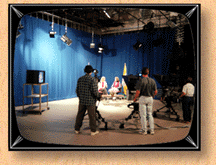

Even if you're already in the video business, every day SOMETHING comes up that is new to you. Today's Video 4th ed. covers a lot of those unusual video subjects. The book is geared to practicing professionals who toil in the video "trenches", and has scores of money-saving shortcuts that work just as well as (sometimes better than) many expensive methods you may be using now.
Do you know:
How to copy a tape that barely plays. Page 387.
"Insider" trick for getting nice color when shooting
under gymnasium sodium vapor lights. Page 188.
What kind of padded envelope should you NEVER use to mail a cassette
or DVD? Page 120.
What feature on the better camcorders do you turn OFF to make
a sharper picture? Page 131.
Step-by-step procedures for salvaging a broken or wrinkled video
tape. Page 473-476.
Simple way to turn your tripod into an easy-to-operate copy stand.
Page 349.
Two dozen travel hints that could save you thousands of dollars
when shooting on location. Page 512-515.
What the manufacturers "forget" to tell you about your
camera's minimum light sensitivity, and the magic words that keep
them honest. Page 152.
Take underwater shots without an expensive underwater camera housing.
Page 166.
The 10 cent substitute for a lost lens cap. Page 179.
If you see this in your camera lens, fix it immediately before
it becomes unfixable. Page 179.
The nasty surprise your clients get when they play your edited
VHS tapes, and how to avoid it (Hint: It has to do with audio).
Page 400.
The common mistake with time code that drives editor controllers
and nonlinear editors mad. Page 406.
What food should you never eat while editing --- it will make
you think you have glitchy edits. Page 432.
Which VCRs make the best copies, which VCRs to absolutely avoid.
(Chapter 13).
Little known shooting trick that saves one whole generation when
editing. Page 414.
The one, often-forgotten switch that can ruin your video signal
without you even noticing it until it is too late. Page 23.
A technique for viewing RGB video without an expensive RGB monitor.
Page 26.
The 10 cent cure for ripply bars or lines showing on your TV monitor.
Page 29.
Creative cable TV hookups that send any signals (including scrambled)
to any VCRs or TVs the way you want them. Pages 54, 55, 81, 82.
What is the one filter your camcorder should always be wearing?
(It's also inexpensive). Page 184.
Three tricks for easily removing a stuck lens filter. Page 188.
What essential thing does everybody forget to record on-location?
(Hint: It has to do with editing audio.) Page 286.
When to use (and when never to use) audio gates, reverbs, and
compressors. Page 287.
Unlike analog audio, digital audio volume levels must never be
allowed to do what? Page 300.
Seven cheap tricks that slash the cost of set building. Page
354.
Thirteen secrets to shooting video so that it looks good on the
web or on a CD-ROM. Page 366.
Six camera tricks to shoot faces the most flattering way. Page
209.
Twenty-three easy camera angles you probably haven't thought of
(but the pros use them all the time). Chapter 8.
Save 75% when buying TV lights. Page 226, 227.
Get 10 times the light for the same amount of power (it's portable,
and especially flattering to faces). Page 235.
Which colors look awful on TV; which ones look great. Page 290.
Untold secrets to the "perfect" chroma-key. Page 243,
319.
The common mistake that ruins countless quartz light bulbs. Page
251.
Banishing audio hum ... the right way. Pages 259, 293.
The common mistake in placing a shotgun microphone that ruins
its directionality. Page 257.
How to increase the range of your wireless mike with just an alligator
clip and a rubber band. Page 266.
This common mistake when setting up two mikes on a podium ruins
the sound (and you probably won't notice the problem in time to
fix it). Page 270.
An excellent mike windscreen for under a buck. Page 271
The little known difference between the audio inputs/outputs of
pro gear and consumer gear that can wreck your sound. Page 278.
Colors you should never use for graphics and text. Page 338.
For a successful TV interview, always lead with this kind of question.
Page 502.
Ten gruesome yet realistic makeup effects using inexpensive household
materials. Page 511, 512.
End the confusion about what the differences are between Y/C,
Y/I/Q, Y/(R-Y)/(B-Y), 4:1:1, 4:2:2, and other video signals. Pages
9, 10, 99, 104.
Make sense of all those strange controls on professional cameras.
Page 146.
Demystify the two essential video signal calibration devices:
the waveform monitor and the vectorscope. Chapter 15.
*******************
TODAY'S VIDEO, 4th. ed. has 553 pages, 898 illustrations,
defines 1200 video terms, and costs $95 from MacFarland Publishing,
any bookstore, or from the author directly (I throw in, for free,
an additional booket, "DVDs and Interactive Video")
by sending a check for $95 (plus $5 shipping in the USA) to:
Peter Utz
12 Valley Rd.
Stanhope, NJ 07874
| About the author | About Today's Video 4th ed. | Return home |